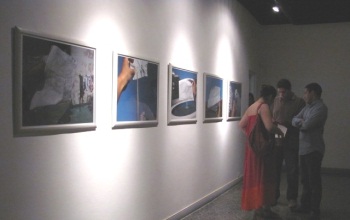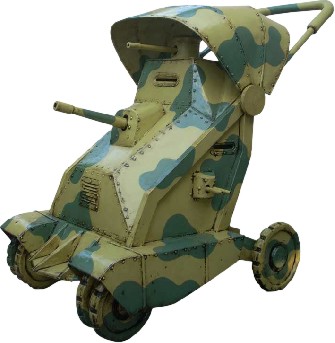
By Xenia Reloba and Hector Bosch
Felipe Dulzaides, One Minute Installation series
Chaos is the name of the collective exhibition showcased at Galeria Habana, May 9 – June 10. It includes artworks of Cuban contemporary creators that stand out in the promotion circuits of world art.
Perhaps the notion of chaos has become less incomprehensible, since scientists have validated it to explain phenomenon of the material world. Whereas, the complexity of society and human beings still leaves open windows for artistic creation, which puts on the map interpretations or representations with different readings.
These symbolic productions also live their own chaotic universe on art market, so the transcendence of their discourse is intimately linked to the commercial promotion of artworks and artists.
In this regard, curator Yadier Perez commented that Galeria Habana has maintained a steady work on international spreading and marketing through auctions, and its presence in other world scenes.
Likewise, he pointed out the importance of a domestic market to boost the artistic product positioning, which turns out to be difficult in the case of Cuba due to the socio-economic conditions.
The expert affirms that they have successfully increased the value of artworks created by representatives of Cuban avant-garde. In the case of contemporary creators, some of them have been positioned in foreign circuits or have established links with art promotion centers overseas, though they keep the charm given by the Isle’s political singularity, «the double sense and even the tensions brought about by the relation with the United States».
A lot of attention lies in “made in Cuba” Cuban art, he mentions, maybe more than in artworks created by artists who migrate and get lost within the world market whirlpool. That interest is encouraged by the work of national institutions and events such as Havana Biennial, which «gathers selected artists» and facilitates the launching of their creations.
Chaos comes within this panorama, from a question that ranges «from the particular to the universal, and deals with the daily life: urban, collective, social, financing», explains.
«Several artists were handpicked, artists from a certain type of market that has been backed up by the work of Galeria Habana and aesthetics, the value of their artworks», creators that haven’t devaluated their proposal in order to facilitate the sales and «have remained strong even increasing prices, participating in biennials», he highlighted.
«Carlos Garaicoa is maybe the paradigmatic case, with constant presence in exhibitions in Europeand United States. As well as Los carpinteros, who are internationally acclaimed», he emphasized.
According to Yadier Perez, the Biennial «is a propitious framework to gather collectors, art enthusiasts, critics, theoreticians, artists. The last ones, sometimes due to work obligations, don’t spend much time in Cuba ordon’t carry out regular exhibitions in the country», and in this aspect he mentioned HB, another showcase to be held in Pabexpo, with authors that haven’t displayed their work in the Isle for a long time.
As for art marketing, the specialist suggests that «although local ideas are highly valuable, they should be understood in other circumstances. This might be a problem for some artists, with relevance for the countries, their societies. But I believe that they have to go further, reach another level, spiritual we could say, other senses».
About Caos
Garaicoa’s pieces included in this exhibition have been carved on bone and allude to the depauperation of the urban environment, in a paradoxical conjugation of beauty and destruction. Meanwhile, Los carpinteros make good use of the symbolism of an object liked to Cuban people’s historic-existential experience: the oil lamp or Chinese lantern.
Yadier mentions brothers Yoan and Ivan Capote, who«have already gained momentum in the North American market». The first one is represented in Caos with an installation-sculpture structured as buildings, symbolically built with labyrinthic padlocksand, as for the second one, a two-dimensional work of marked conceptualism is exhibited.
Felipe Dulzaides

On the other hand, Felipe Dulzaides returns to the city spaces and their influence on individuals, giving them a subversive look through the drawing in the photographic image.
Glenda Leon brings about the hallucination of a forbidden sky in a box of light, and Reynerio Tamayoevokes violence with a toy car turned into war tank.
Here is the staging
On the sui generis call of Galeria Habana, Felipe Dulzaides thinks that there is a common denominator in the pieces: «the sensibility that has to do with conceptual art. The pieces dialogue in minimal language, with references to accidents, architecture, and urbanism».
On his work, he points out that «it has to do with the relation between the individual and the city. I’ve done some research on how it affects out subjectivity. The monuments, the city as such, dictate a state, a behavior. With these small actions the individual is subverting that state».
«The chaos is a very big thing because human beings try to control life and that’s not possible. It’s a fixed formula. When the curator called me, I looked at my work and found a series that responded to this theme», he says, and adds that in the exhibition «everything has a subversive character. There are different means, but language is the best. The format isn’t what gives unity, but the discourse of ideas.»
On market and art, he affirms that there is no «contradiction among the marketing and ethical principles. We live in a world where marketing is a must. Everything costs money. It’s normal, this is my job and this is how I make a living», he emphasized.
«Collectors have another kind of relation with the work because they take it home», he said, and added that it’s very likely that most of the people interested in this kind of art, which isn’t decorative,representinstitutions, since it’s very difficult to be commercialized. «Who buy it are interested in the kind of discourse or in the artist that explorer the idea, and also bet on this work to support the creators», he stressed.
«What’s interesting is that everybody can come and enjoy this showcase and establish a dialogue with the proposal. Afterwards, you have the person with the economic power to coexist with the work. That’s another story. But this is the staging», he summarized.

Beyond the market
Reynerio Tamayo’s Baby carriage
Reynerio Tamayocategorically denies the market interest in the conception of his work for Caos, which makes up «a bellicose series I’m working on. Ideas that aren’t very lucky, but war isn’t, it always causes death».
«I’m not concerned about the market», he affirms, and adds that «that is related to the idea of chaos. I’m interested in stimulating the people, speaking of such a terrible topic as war, which also has to do with the lack of safety on the streets».
His work, a baby carriage turned into an armored car, proposes a «profound reflection on violence. There are some people who consider that it’s too intense and it’s not to be bought. However, you do what you feel you have to do, and Picasso’s Guernica is an example, as well as Goya.»
«I wish there were no war, violence and lack of safety so armored cars weren’t necessary», he summarizes.
It’s clear that we live in a chaotic world, but certain order that be born from Caos, in terms of ethic and aesthetic discourse, just as it’s evidenced in the exhibition showcased at Galeria Habana during the 11th Biennial.













